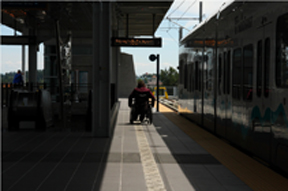Spinal Cord Injury Update
Summer 2010: Volume 19, Number 3
Riding the Rails:
Testing out Sound Transit’s Light Rail in a Wheelchair
By Aditya Ganapathiraju
Seattle was recently rated #1 among the “Top 20 Most Livable U.S. Cities for Wheelchair Users” by the Christopher & Dana Reeve Foundation, which included criteria such as climate, access to rehabilitation, fitness and recreation, accessibility of housing, and the big one: wheelchair-accessible transportation. (For the record, I have a C5/6 incomplete spinal cord injury and use a power wheelchair.)
As a frequent mass transit user, I decided to check out Link Light Rail, the newest addition to Sound Transit, the region’s public transportation system. Link offers service from Westlake in downtown Seattle to SeaTac Airport, about 15 miles south.
You can access Light Rail from any of the downtown tunnel stations used by Metro buses. I entered the Pine Street Station from 4th Avenue. There are elevator entrances to the transit tunnel on both sides of the street—however, one of the elevators didn’t work; this, along with the delightful smell, convinced me to go to the other side. The elevator button was up high and hard to reach, but I managed to push it and arrive at the mezzanine floor, where you can buy Light-Rail tickets at two automated ticket booths or the customer service center.
You must purchase your fare before getting on the train, with either a prepaid ORCA card or tickets purchased at the station. Ticket personnel make regular sweeps through the train, so don’t get caught without a ticket. With a Regional Reduced Fare Permit card the fare ranges from $.75 to $1.25 from downtown to SeaTac. (See Ticket and Access Information, below, for details.)
Take another elevator down to the main platform labeled “Light Rail to SeaTac Airport.” Trains come about every 15 minutes. There is a small two-inch gap between the platform and the train which power chairs can traverse with ease, but manual wheelchair users will need to exercise caution and may end up having to wheelie over the gap.

Sporting an all-electric power system, the Japanese-manufactured trains accelerate smoothly to a top speed of 55 mph. At cruising speed, however, the ride got shaky, and I had trouble taking notes on my iPod touch. (I concluded that you would definitely spill your martini—if alcohol were allowed on the train — but your covered coffee mug would be fine.)
I arrived at SeaTac Airport 35 minutes after leaving Westlake. Even with all the station stops in between, this time is comparable to driving a car, and faster if traffic is bad (which is most of the time in Seattle).
If you think you’ll need additional time to exit the train, you can press the ominous red “EMERGENCY INTERCOM” button located in the wheelchair area. Since I had seen how briefly the doors stayed open, I pressed this button before the SeaTac stop so I would have enough time to get off. To my embarrassment, the conductor’s voice boomed over the intercom:”You pressed the red button! What’s your emergency?” I responded sheepishly that there was no emergency, but I needed extra time to get off the train. He loudly reminded me that SeaTac was the last stop and I wouldn’t need extra time. Cringing, I resolved never to press the dreaded “EMERGENCY INTERCOM” button again.
After getting off the train, you still need to traverse about a half-mile of flat, covered walkway and an elevator ride to reach the airport terminals. In a power chair this little segment took a few minutes; in a manual chair the trip might be a bit tiring. If you plan to haul your own luggage, give yourself extra time.
All in all, Sound Transit’s Light Rail offers a relatively quick ride to the airport and may be your best bet if you want to travel quickly to and from the Sounders (soccer) game, enjoy some Friday night revelry downtown and make it back without driving, or just visit some friends south of Seattle.
Ticket and Access Information
- How to obtain a Regional Reduced Fare Permit: http://www.soundtransit.org/Riding-Sound-Transit/Fares-and-Passes.xml
- ADA accessibility: http://www.soundtransit.org/Riding-Sound-Transit/Accessibility-and-ADA.xml
- Regional Reduced Fair Permit application form (to be signed by your physician): http://metro.kingcounty.gov/tops/accessible/RRFP-app.pdf
- About Sound Transit: http://www.soundtransit.org/Riding-Sound-Transit/Schedules-and-Facilities.xml
Aditya Ganapathiraju, a research assistant in rehabilitation medicine at the UW, responsibly enjoys his martinis before boarding public transportation. He has a C5 level injury, but swears he feels like a C7 on good days. And like the late John Callahan, he too celebrates “the lighter side of being paralyzed for life.”






